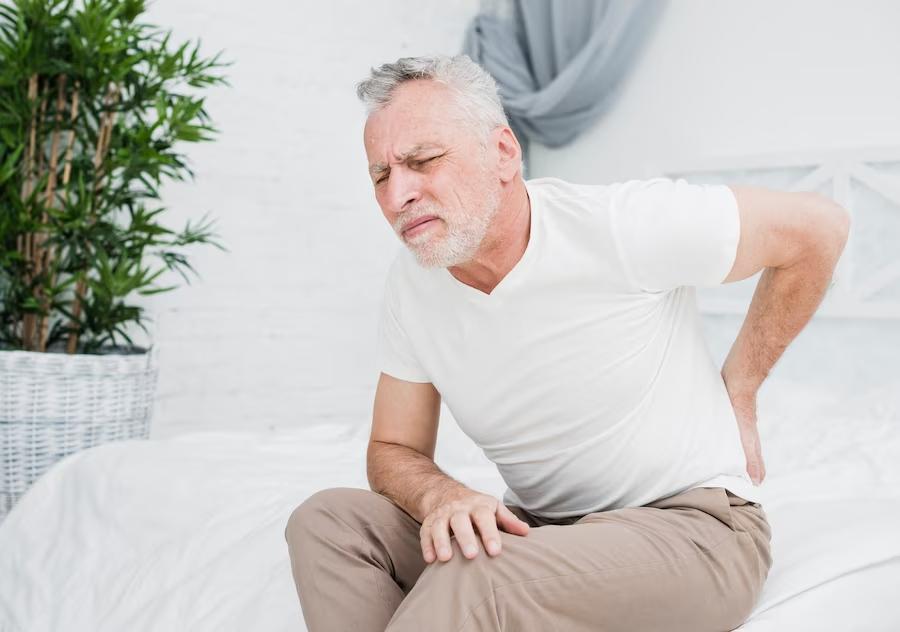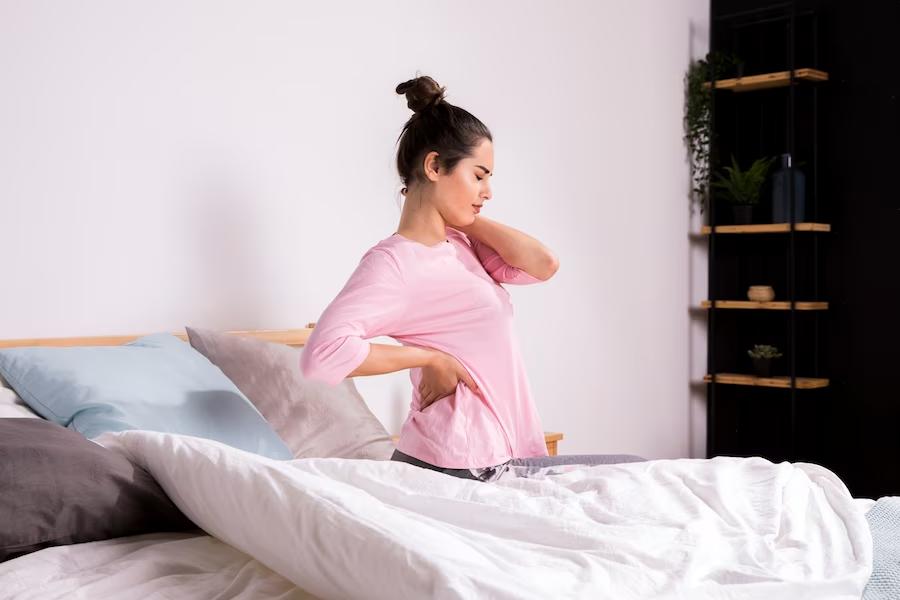Discover Orthopaedic Solutions for Lower Back Pain Relief
- Home
- Discover Orthopaedic Solutions for Lower Back Pain Relief


Back pain is an issue that impacts individuals of every age group. It can arise from reasons such as injury, bad posture and stress. Typically, home remedies can alleviate instances of pain. Yet if your discomfort is intense or persists despite home interventions. consulting an orthopedic or healthcare expert may be necessary.

(Source:https://www.freepik.com/free-photo/elder-man-with-back-pain_4762066.htm#query=lower%20back%20pain&position=7&from_view=search&track=ais)
In today’s world back pain is a problem that impacts individuals. As remote work becomes more prevalent a new concern has emerged. Back discomfort stemming from lifestyles and extended hours spent hunched over a computer screen. This sedentary behavior can result in weight gain and muscle atrophy heightening the vulnerability of individuals to back injuries. Moreover prolonged sitting can amplify the pressure, on the back area elevating the likelihood of sustaining an injury.
When your back hurts it can stem from a mix of three reasons. Muscle related back pain often happens when the lower back muscles are overworked, resulting in aches or cramps. Pain from a disc issue occurs when the outer fibers of the disc tear, leading to pain and potentially causing the disc to bulge. Back and buttock pain can also arise from facet issues, where the spinal joints wear down and trigger discomfort.

(Source:https://www.freepik.com/free-photo/fitness-woman-waking-up-morning_4871141.htm#query=lower%20back%20pain&position=19&from_view=search&track=ais)
Depending on what’s causing your pain and how severe it is, you might consider trying some home remedies to ease the discomfort until your back feels better.
Stretch – When your back muscles are tight, it can add pressure on your spine and its joints. Developing a routine of stretching exercises can help maintain the health of your back.
Proper posture – Poor sitting posture can strain the discs in your lower back. If you have to sit for extended periods remember to take breaks and move around frequently.
Walk – Walking is a beneficial activity. Increasing your pace while at work or outdoors can help you maintain a weight and reduce strain on your back.
Avoid sleeping on your back – Sleeping in a position can stress the spine. Placing a pillow under your knees when lying on your back can help alleviate this strain. For side sleepers, placing a pillow between the knees may reduce discomfort.

(Source:https://www.freepik.com/free-photo/woman-s-hand-he-is-caught-waist-her-back_5216326.htm#page=3&query=lower%20back%20pain&position=6&from_view=search&track=ais)
The typical approach to addressing pain involves treating the underlying issue. Various medications can be used to alleviate discomfort. Acetaminophen is known for providing relief with side effects. Non-steroidal anti-inflammatory drugs like aspirin, ibuprofen and naproxen are commonly prescribed to reduce pain and swelling. Steroids, whether taken orally or injected into the spine, offer a dose of inflammatory medication. Muscle relaxants such as methocarbamol, carisoprodol and cyclobenzaprine can be beneficial but may cause drowsiness. It’s advisable to avoid activities like driving that require alertness while using them.
Addressing back pain often involves a combination of medications, therapeutic approaches and physical exercise. Treatments like heat therapy, ice packs, massage therapy, ultrasound treatment and electrical stimulation are sometimes utilized for relief. Active therapies including stretching exercises, weight training and aerobic workouts may be suggested to enhance mobility and strength in the area. While braces, chiropractic care and traction can also be options. Some individuals may also experience relief through exercise centered programs like pilates or yoga.
Moreover, surgery is usually considered if the orthopaedic surgeon can pinpoint the cause of the pain. This would also depend on the severity of the patient’s condition. Surgery isn’t always the choice if alternative treatments haven’t worked. Certain individuals experiencing back pain may not be good candidates, for surgery no matter how intense their pain is. There are situations where surgery is not a primary solution.
The cause of back discomfort isn’t always easy to pinpoint. It may improve on its own. Resting, using heat or cold therapy, taking over the counter pain relievers and doing stretches can aid in the healing process. However, it’s crucial to see a healthcare professional if the pain is intense, persistent or accompanied by symptoms like tingling or numbness in the legs. Immediate medical attention should be sought if along with back pain, one experiences difficulty walking or moving their legs, loss of bowel or bladder control, decreased sensation in the legs or severe pain. An orthopaedic surgeon can diagnose the underlying issue behind the pain and recommend an appropriate treatment plan.
It is not uncommon to experience back pain. There are a few potential causes, from sprains to medical conditions, as well as being overweight or inactive. Fortunately, most lower back pain can be resolved within days or weeks without surgery, and there are some preventive measures that can be taken to avoid it in the future.
Exercise – If you are experiencing back pain, you may believe that taking a break from physical activity and resting are the best ways to get relief. Although a couple of days of rest can be beneficial, more than that may not be the best option. Regular exercise can help to reduce inflammation and muscle tension.
Watch your weight – Having too much weight, especially around your abdomen, can contribute to back pain by altering the balance of your body and putting strain on your lower back. Keeping your weight within 10 pounds of your optimal weight may help reduce back pain.
Stop smoking – The restricted flow of nutrient-rich blood to spinal discs caused by smoking puts smokers at an increased risk of experiencing back pain.
Get enough sleep – If you have a tendency to experience back pain, it would be wise to consult a medical professional about the ideal sleeping position. It is sometimes advised to sleep on one’s side with your legs slightly bent towards your chest. If you are more inclined to sleep on your back, it is suggested to place a pillow under your knees and another one under your lower back.
Lower back pain is a common condition that can be caused by a variety of factors. There are many effective treatments available, and your doctor can help you find the best one for you. If you are experiencing lower back pain, it is important to see a doctor to get a diagnosis and discuss treatment options. With the right treatment, most people can find relief from lower back pain and get back to their normal activities.
Lower back pain is pain in the lower back, which can range from mild to severe. It is a common condition that affects people of all ages.
There are many causes of lower back pain, including:
● Injury, such as a muscle strain or a herniated disc.
● Degenerative conditions, such as arthritis or osteoporosis.
● Pregnancy.
● Obesity.
● Poor posture.
● Stress.
The diagnosis of lower back pain is usually made based on your medical history and physical examination. Your doctor may also order imaging tests, such as an X-ray or MRI, to rule out other conditions.
There are many ways to treat lower back pain, including:
● Rest.
● Ice or heat therapy.
● Over-the-counter pain medication.
● Physical therapy.
● Injections.
● Surgery.
You should see a doctor for lower back pain if:
● The pain is severe or does not improve with home treatment.
● The pain is accompanied by other symptoms, such as fever, numbness, or weakness.
● You have a history of cancer or other serious medical conditions.
Surgery is usually only recommended for severe cases of lower back pain that do not respond to other treatments. There are risks associated with any surgery, including:
● Infection.
● Bleeding.
● Nerve damage.
● Reaction to anesthesia.
There are a few things you can do to help prevent lower back pain, including:
Maintaining a healthy weight.
● Exercising regularly.
● Stretching.
● Good posture.
● Avoiding lifting heavy objects.
There are many new treatments being developed for lower back pain, including:
● Stem cell therapy.
● Platelet-rich plasma injections.
● Electrical stimulation therapy.
● Artificial intelligence-guided treatment.

Dr Yong Ren graduated from the National University of Singapore’s Medical faculty and embarked on his orthopaedic career soon after. Upon completion of his training locally, he served briefly as an orthopaedic trauma surgeon in Khoo Teck Puat hospital before embarking on sub-specialty training in Switzerland at the famed Inselspital in Bern.
He underwent sub-specialty training in pelvic and spinal surgery, and upon his return to Singapore served as head of the orthopaedic trauma team till 2019. He continues to serve as Visiting Consultant to Khoo Teck Puat Hospital.
Well versed in a variety of orthopaedic surgeries, he also served as a member of the country council for the local branch of the Arbeitsgemeinschaft für Osteosynthesefragen (Trauma) in Singapore. He was also involved in the training of many of the young doctors in Singapore and was appointed as an Assistant Professor by the Yong Loo Lin School of Medicine. Prior to his entry into the private sector, he also served as core faculty for orthopaedic resident training by the National Healthcare Group.
Dr Yong Ren brings to the table his years of experience as a teacher and trainer in orthopaedic surgery. With his expertise in minimally invasive fracture surgery, pelvic reconstructive surgery, hip and knee surgery as well as spinal surgery, he is uniquely equipped with the tools and expertise necessary to help you on your road to recovery.